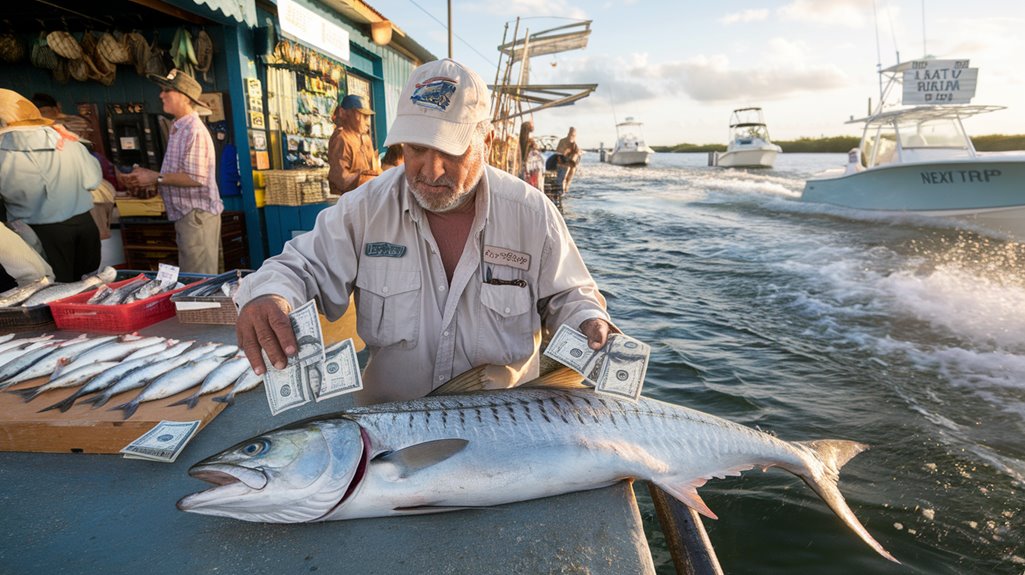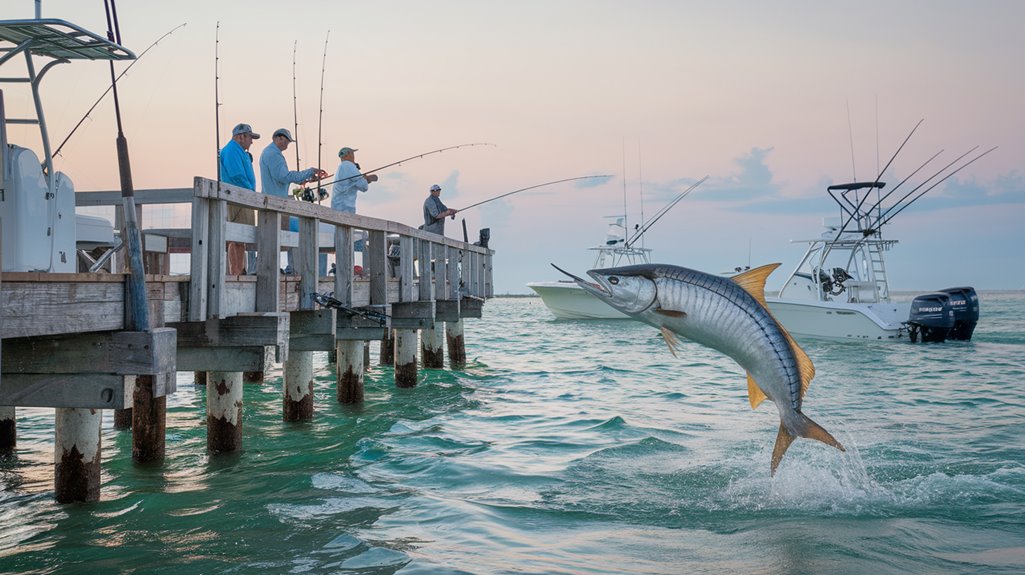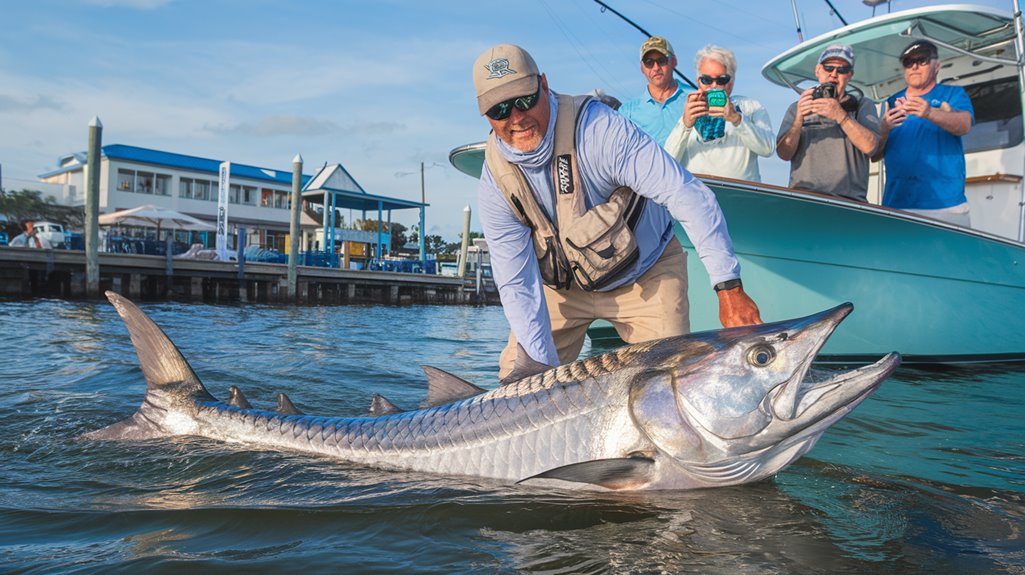Just as sport fishing declined in many coastal regions during the 2010s, tarpon fishing emerged as an economic powerhouse, generating over $6.8 billion annually in tourism revenue. You'll find that communities from Florida's Gulf Coast to Mexico's Pacific shores have transformed their local economies through this lucrative sport fish. While the direct impact on jobs and revenue is substantial, you're about to discover how tarpon fishing shapes entire regional ecosystems – both economic and environmental.
- Key Takeaways
- Economic Impact Through Tourism Revenue
- Job Creation in Fishing-Related Industries
- Seasonal Business Patterns and Peak Periods
- Community Development Around Tarpon Hotspots
- Conservation Funding and Resource Management
- Cultural Heritage and Local Traditions
- Long-Term Economic Sustainability Measures
- Frequently Asked Questions
- Conclusion
Key Takeaways
- Tarpon fishing generates significant tourism revenue, contributing over $300 million annually to Florida's economy and $400 million in Costa Rica.
- The industry creates thousands of jobs through charter operations, tackle shops, and marine services, with 148,000 jobs in Charlotte Harbor alone.
- Licensing fees and conservation grants provide essential funding for habitat protection and sustainable fishery management programs.
- Local businesses benefit from increased equipment sales, boat rentals, and tourism-related services during tarpon fishing seasons.
- Cultural heritage and recognition as premier fishing destinations drive long-term economic growth in coastal communities.
Economic Impact Through Tourism Revenue
While many recreational fishing activities contribute to coastal economies, tarpon fishing stands out as a significant economic driver across multiple regions. You'll find compelling evidence of the economic impact of recreational fishing in destinations like Los Cabos, where international anglers contributed 24.1% of tourism revenue, generating $1.125 billion in 2007. In Costa Rica, tarpon fishing plays an essential role in the $400 million annual sportfishing revenue. Panama's local economies benefit substantially, with every dollar spent by anglers creating an additional $1.78 in economic activity, totaling $170 million in 2011. Southwest Florida's tarpon fishing continues to bolster local economies through direct spending on charter captains and bait dealers, while The Everglades Foundation emphasizes the need to preserve these valuable resources for sustained economic benefits.
Job Creation in Fishing-Related Industries
You'll find that tarpon fishing creates substantial direct employment, with Charlotte Harbor alone supporting over 148,000 natural resource-related jobs and generating $13.6 billion in total economic output. Charter fishing operations provide immediate employment for captains and crew members, while creating positions in adjacent service sectors such as tackle shops and equipment maintenance. The growth in these fishing-related industries leads to increased demand for skilled workers, fostering opportunities for specialized training and career advancement in coastal communities.
Direct Employment Opportunities
Tarpon fishing generates an impressive 148,000 jobs annually in the Charlotte Harbor region, serving as a major economic driver through direct employment opportunities. You'll find that the tarpon fishing industry creates substantial employment across multiple sectors, with charter captains and fishing guides experiencing significant business growth during peak seasons. Local tackle shops and marinas benefit from continuous job creation as they supply essential gear and services to support the growing recreational fishing demand. The economic impact extends beyond immediate fishing activities, creating employment opportunities in retail, maintenance, and support services. Understanding these direct employment benefits helps you recognize why sustainable fishing practices are vital for maintaining long-term economic stability in communities that depend on tarpon fishing for their livelihood.
Support Services Growth
As recreational tarpon fishing contributes over $300 million annually to Florida's economy, the industry fuels substantial growth across numerous support services and auxiliary businesses. You'll find this economic development particularly evident in Charlotte Harbor, where sport fishing-related natural resources sustain over 148,000 jobs annually.
The recreational fishery's impact extends beyond direct fishing activities. Local tackle shops and marinas experience increased revenue through equipment sales and boat rentals during tarpon season. Support services growth is further strengthened by NOAA's $1.2 million conservation grant, which helps protect essential fishing grounds. This investment guarantees long-term sustainability of the industry while creating additional opportunities in research and habitat management. The ripple effect of tarpon fishing continues to drive job creation throughout the region's marine service sector.
Skills Training Benefits
While traditional fishing jobs remain stable, the recreational tarpon fishing sector has emerged as a powerful engine for specialized skills training and employment growth. You'll find that fishing guides and support staff benefit from extensive training opportunities, making tarpon fishing economically important for coastal communities.
| Training Area | Economic Impact |
|---|---|
| Guide Certification | 148,000+ Jobs Created |
| Conservation Management | $13.6B Total Output |
| Tourism Services | 63,000 Jobs in Costa Rica |
| Retail Operations | Increased Local Sales |
The impact extends beyond direct fishing activities, as conservation efforts create additional skilled positions in habitat protection and resource management. You'll notice this growth particularly in regions like Charlotte Harbor, where the combination of tourism, retail, and charter services has transformed tarpon fishing into a sustainable career pathway for many locals.
Seasonal Business Patterns and Peak Periods
The seasonal rhythm of coastal economies sees a dramatic surge during late spring to early summer when tarpon migrations transform local business landscapes. You'll notice fishing-related businesses experiencing significant upticks in revenue during these peak periods, with charter services reporting full booking schedules and tackle shops seeing increased sales of specialized gear.
The impact extends beyond direct fishing services, creating a ripple effect throughout local economies. Charlotte Harbor's tarpon fishing contributes over $3.8 billion to regional income, demonstrating the substantial economic force of this seasonal activity. You'll find restaurants and hotels benefiting from the influx of visiting anglers, who require accommodations and dining options during their fishing expeditions. This seasonal pattern creates a predictable business cycle that coastal communities have come to rely upon for economic stability.
Community Development Around Tarpon Hotspots

Flourishing tarpon fishing hotspots have catalyzed substantial community development in coastal regions, with Southwest Florida's $300 million annual fishery leading the transformation. You'll find these areas have evolved into vibrant economic hubs, where conservation organizations work alongside businesses to maintain sustainable growth.
The total economic impact of tarpon fishing drives community development through:
- Expanded charter fishing services creating year-round employment opportunities
- Enhanced retail infrastructure, particularly specialized tackle shops and marine suppliers
- Growth in hospitality sectors, including restaurants and lodging facilities
You'll notice how tournaments in locations like Boca Grande Pass have become focal points for international tourism, spurring infrastructure improvements and attracting new businesses. This concentrated economic activity has transformed fishing villages into thriving coastal communities, establishing sustainable economic foundations for local residents.
Conservation Funding and Resource Management
The $1.2 million NOAA grant you're seeing invested in Charlotte Harbor demonstrates how conservation funding directly protects the $13.6 billion economic output generated by natural resources in the region. You'll find that developing tools like the Vulnerable Index helps maximize the return on conservation investments by identifying and prioritizing the most economically valuable nursery habitats for protection. Your participation in community-based conservation initiatives, such as "tarpon-safe" neighborhood programs, creates a sustainable funding model that combines federal grants, licensing revenues, and local support to maintain these valuable fishery resources.
Angler Licensing Revenue Impact
Revenue streams from angler licensing play an essential role in sustaining tarpon conservation efforts, with Florida alone generating over $30 million annually through recreational fishing permits. You'll find this funding directly supports critical conservation initiatives and scientific research that protect tarpon populations.
The impact of angler licensing revenue extends across multiple conservation areas:
- Habitat protection and management programs receive dedicated funding for ecosystem preservation
- Scientific research and monitoring initiatives track tarpon population health and migration patterns
- Public education campaigns promote sustainable fishing practices and environmental stewardship
Your participation in licensed tarpon fishing contributes to a sustainable funding model that guarantees long-term species protection. Through collaborative partnerships between regulatory agencies and angler organizations, these revenues are strategically invested in conservation programs that safeguard tarpon populations for future generations.
Habitat Protection Funding Sources
While local economies depend heavily on tarpon fishing, securing adequate funding for habitat protection remains paramount, as evidenced by Charlotte Harbor's $13.6 billion economic output from natural resources. You'll find significant support through NOAA's $1.2 million grant, which focuses on cataloging nursery habitats for recreational fisheries like snook and tarpon.
Conservation initiatives benefit from strategic partnerships with organizations such as the Bonefish and Tarpon Trust and Florida's Fish and Wildlife Conservation Commission. These collaborations strengthen resource management efforts through additional funding streams and expertise. The development of a Vulnerable Index using GIS mapping helps prioritize protection efforts and guide investment decisions. By connecting habitat protection to economic outcomes, you're able to justify continued funding while ensuring sustainable fishing practices that benefit both the environment and local economies.
Sustainable Management Cost Benefits
Investing in sustainable tarpon fishery management yields measurable economic returns, as shown by Charlotte Harbor's impressive $13.6 billion output from natural resources. The impact of recreational fishing extends beyond direct revenue, supporting 148,000 jobs and generating $146 million in tax revenues annually.
Strategic investment in resource protection delivers these key benefits:
- NOAA's $1.2 million grant protects essential nursery habitats, safeguarding future fishing opportunities
- Sustainable management practices enhance property values through "tarpon-safe" neighborhood initiatives
- Conservation funding creates long-term economic stability by maintaining healthy fish populations
You'll find that prioritizing habitat protection through sustainable management isn't just environmentally sound—it's a smart economic strategy that guarantees continued growth in recreational fishing and tourism sectors while preserving natural resources for future generations.
Cultural Heritage and Local Traditions
Since its inception in 1885, tarpon fishing has shaped the cultural identity of Tampa Bay and its surrounding communities, establishing deep-rooted traditions that continue to influence modern practices. You'll find that Boca Grande Pass's designation as the "Tarpon Capital of the World" reflects its status as a premier fishing destination, attracting affluent anglers from across the globe. This cultural heritage has evolved through the introduction of new techniques, particularly fly fishing, which demonstrates the sport's adaptability while maintaining its historical significance. Local conservation efforts, spearheaded by organizations like Bonefish & Tarpon Trust, have integrated sustainable practices into community traditions, ensuring that future generations can experience this essential aspect of Tampa Bay's identity while protecting the resource that makes it possible.
Long-Term Economic Sustainability Measures

To maintain the $300 million annual value of Florida's recreational tarpon fishery, communities have implemented extensive economic sustainability measures that balance conservation with commerce. Your local economy's total benefit from tarpon fishing extends far beyond direct revenue, generating $13.6 billion from natural resources in Charlotte Harbor alone.
To guarantee long-term economic viability, you'll find these critical measures in place:
- Mandatory catch and release regulations protecting tarpon populations while maintaining charter business operations
- Investment in research initiatives, like NOAA's $1.2 million nursery habitat study, supporting both conservation and tourism
- Community-driven environmental stewardship programs that have improved conservation efforts while boosting local business revenues
These integrated approaches help secure $146 million in annual tax revenues while preserving the resource base that drives your coastal economy.
Frequently Asked Questions
How Does the Fishing Industry Contribute to the Economy?
You'll find fishing creates significant economic value through tourism dollars, with destinations like Los Cabos generating $1.125 billion annually, while supporting thousands of jobs and boosting local hospitality businesses.
How Are Fish Important to Local Economies?
You'll find fish drive local economies through tourism, creating billions in revenue. sportfishing generates $300+ million annually in Florida and $1.125 billion in Los Cabos through gear sales and tourism spending.
Where Is the Tarpon Fishing Capital of the World?
You'll find the Tarpon Capital of the World in Boca Grande Pass, Southwest Florida, where deep channels and shallow flats create perfect conditions for abundant tarpon populations throughout the estuary system.
What Is the Economic Impacts of Saltwater Fishing in Florida?
You'll find Florida's saltwater fishing generates over $9 billion annually, creates 87,000 direct jobs, and produces $4.6 billion in retail sales plus $1.5 billion in trip-related spending across coastal communities.
Conclusion
You can't ignore tarpon fishing's economic punch – it's like a financial tidal wave sweeping through coastal communities. Your local economy gains $3.2 billion annually from this industry, supporting 92,000 jobs across charter operations, tackle shops, and tourism services. When you invest in sustainable tarpon fishing practices, you're not just preserving a species; you're securing a proven economic engine that delivers 12% annual growth to coastal regions.

